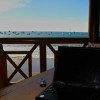F´d Up Economics of Tourism in Uyuni Bolivia
| by Aracely | 16 Comments » | Bolivia, Reflections, South America
I think it was during the first days of our trip. We were in Guatemala having a conversation with Andy and Paulina, another traveling couple from England, when we first heard that the Uyuni Salt Flat Tour was amazing. Bolivia was definitely in our plans but we try not to have an itinerary more than a few days ahead so at the time, there was no to-do list for our visit to Bolivia.
While traveling for a few months and meeting more travelers making their way up from the south of South America to the north, opposite of our route, we continued to hear great things about the Uyuni Salt Flats. The destination quickly made its way up to my top three most anticipated events of this trip. Torres del Paine National Park in Chile and the famous archeological site of Machu Picchu were the others on that list.
I was not disappointed. Everything we heard about the Salt Flats was true; it lived up to the expectation, which does not always happen with every place. Not only was the experience one of a kind, but our guide was very informative, we met new friendly people, saw unique and unforgettable scenery and took over 750 pictures within a four days.
I’m not going to describe the amazing scenery of this tour or what it felt like to watch the sun rise in such a unique landscape. Instead, I need to vent about something that disturbs me very much. I am referring to the conditions of the town of Uyuni, which is the departure point for over 60% of the salt flat tours. Uyuni is a poorly developed and dirty town and I struggle to understand why.
There is trash everywhere. As you enter Uyuni from the Salt Flats you drive by a field of garbage, and as you depart en route to Potosi, the landscape is littered with plastic bags.
The bags blow in the wind until punctured by the branches of the dry brush that holds onto them for eternity. The plaza is not very inviting either and the streets and buildings look like they are on the verge of collapse.
Why does a town that yields a tremendous amount of money from tours not have trash bins on street corners or a trash collection process? In truth, I am not shocked that a town can and does look this way. We have been traveling through Central and South America for the last nine months and have seen many poorly developed and dirty towns, but their economic situation and lack of resources were reasonable explanations for their conditions. No other place has confused me like Uyuni.
I am aware there are other tourist towns that have inequality and poverty gap issues. In those cases I was able to explain or at least rationalize the disproportionate income levels of its population or their poor urban planning. Uyuni is a different animal; an unexplainable one for me.
I began to obsess and started to calculate the numbers to find a reason and explanation. I asked our guide how many vehicles visit the Salt Flats daily. He gave me some statistics, the integrity of which I question, but for the purposes of feeding my obsession I used them to create the following conclusion.
Uyuni tour agencies generate approximately $776K US dollars of profit per year.
See details of the calculation at the end of the article.
A trash can costs about $4 US dollars.
Does this mean that not a single tourist agency in the past 20 years has taken the initiative to clean up their town? Not even for the sake of the tourists and revenue opportunity? Where is the money going? There were seven tourists in our Uyuni tour and Jason and I were the only ones who stayed longer than just a few hours in Uyuni. Most people who visit the Salt Flats do not spend anytime in Uyuni. Under the conditions of the town, I don’t blame them.
We heard that many of the tour agency owners live in the capital city of La Paz, which means the profits aren’t being spent locally. What about the taxes?
What about the local people living in Uyuni? Why have they not demanded that some of the money which is being generated from the tours be reinvested in their town? Is this an education issue, or does the situation reek of political corruption? Does anyone out there have an answer for me?
___________________________________________________________________
Details of Calculation
Revenue:
According to our guide Milton, approximately 60 vehicles come to the Salt Flats every day during the low season and 80 during the high season, which is only 3 months (June, July and August) of the year. Each vehicle carries 4-6 tourist. I used the number 4 to be conservative. Each person pays an average of 300 Bolivianos per day for the tours. At 80 vehicles for 90 days and 60 vehicles for 270 days (I only used 360 days for the year to allow for holidays or weather issues) paying 1,200 Bolivianos per vehicle (4 tourists x 300 each) that means that $28,080,000 Bolivianos in revenue are generated from the Salt Flats per year. This is equivalent to $4,011,429 US dollars.
Expenses:
Obviously there are costs associated with running such an operation and I used some additional assumptions to come up with a reasonable estimate. I know these are not completely accurate but my finance background makes me comfortable with the educated guesses.
First, I came up with the following expenses: vehicle purchase and maintenance, fuel, guide, cook, food, accommodations, and overhead (running the tourist office.) I then applied dollar amounts to each cost. For example, I assumed that each guide is paid $100 Bolivianos per day and each cook $50 Bolivianos per day and so on.
Based on the expenses above, I estimated that the total cost to generate the previously mentioned US dollar revenue is $2,717,237 US dollars.
Profit:
This means that the aforementioned revenue and expense yields $1,294,191 USD or 32.3% of profit per year. This is a total for all tours visiting the Salt Flats including San Pedro de Atacama, La Paz, Tupiza and Uyuni.
Previously I mentioned that 60% of the tours leave out of Uyuni. If we then also assume that 60% of the profits are generated from Uyuni tour agencies then $776,515 US dollars are generated our of Uyuni.


























I think two of the big factors are probably location and property rights. From taking a quick look at Salar de Uyuni on Wikipedia, it looks like its in a relatively remote location. The location and limited infrastructure combined with low incomes likely causes a shortage of good construction material as well as loads of other problems.
About all of the garbage, my bet is that the salts are owned/operated by the government. If you are interested, you can check out these two articles:
http://www.thefreemanonline.org/columns/why-socialism-causes-pollution/
http://mises.org/daily/4464
The government has less incentive to monitor and maintain the land, leading to more pollution. The same thing is true in the US. The most polluted land is almost always government owned (although some government land is also extremely clean). Setting up a legitimate system of property rights and a legal system that supports them is the best thing that can happen to the environment.
If the salt flats were sold or leased to a private non-profit company and a legal system allowed them to monitor and collect damages, there would not be nearly as much environmental degradation.
Rob, thanks for the input. To clarify, the Salt Flats of Uyuni, the park, is clean. We are referring to the town of Uyuni, which is not located on the salt flats or in the park. There are some hotels, built of salt bricks in the park, but it’s not a town, and it’s not Uyuni. Uyuni is the base town for tours to the Salt Flats, and lies about 25 minutes outside the Flats. The town only exist for the soul purpose of Salt Flat tourism. The town is strangely underdeveloped and dirty. It’s strange because it draws well over 60,000 visitors a year, yet you wouldn’t know it by the looks of the town.
Interesting. It might be an incentive problem them. If there are no other local towns to compete with, they have little incentive to make the town more attractive. Unless of course, they think that the town can be turned around enough to the point where tourists would want to spend more time there.
There is NO competition around. That’s a good point. There are also no fancy restaurants, no jewelry stores or other upscale tourist shops that typically exist in high traffic tourist destinations.
Rob made a good point about incentive, and your lack of competition observation was imo correctly to the point.
There are several other problems, mostly dealing with location. Bolivia is the most sparsely-populated nation in LatAm, in part due to its unbelievably torturous and ever-changing geology (whether by rockslide, earthquake or flood) therefore roads are few and far between and according to generous westernized standards—and like much of the country–poor. I can’t imagine a more difficult terrain to build or maintain roads in, let alone drive on. Descriptions are inadequate for understanding—one has to go there.
Also, Uyuni can be bitterly/bitingly cold, the buildings poorly insulated and often with no central heating or totally unheated and let’s face it—it is centrally isolated smack-dab in the middle of nowhere—and there is a reason for that.
But yes, Uyuni can change and is changing to better accommodate tourism.
Let’s just hope that the changes are for the better and that too many tourists don’t destroy what they all came to see—Uyuni excepted—one of the least human-spoiled and naturally beautiful places on earth.
locoto
I am totally with you in your disgust of the trashing of some of the most extraordinary places on earth, and for all involved I’d love to see it stopped, too–and see beautiful Bolivia without her trash. I’ll try to answer your question best as I can, though admittedly it is from a gringo’s perspective and should be taken as such.
From my observations (from before Evo and since):
It is in large part from the incredible poverty, and living oppressed by/with it for 5oo years. It’s a living condition that has been intentionally-imposed for many generations, and it is part of a chain of oppression and the habits acquired, that are difficult to break.
It’s also the tourism companies that can cheat the government out of taxes in a hundred different ways, and,,,
It’s that the garbage pails would likely be stolen if put out without chains, and,,,
It’s that there is no money to collect the garbage and no place to put it once collected, and,,,
It is also as you noted—plastics. Before the gush of tourism hit Bolivia, the use of plastics was sparse—because they are relatively expensive—compared to nothing or even paper. So until relatively recently, most of the trash recycled naturally quite readily.
Some communities do have garbage pick up, and some look quite wonderful. Often, what happens to the trash is that it is collected, driven to and dumped in a dried up river-bed, where the really really poor, then pick through it, gathering what bits they can to sustain themselves. Believe me, though not as bad as huge municipal dumps, outside Rio or Calcutta, it isn’t very pretty, and of course after the next downpour, the remainder goes to whichever country happens to be downstream.
I am confident that, sometime in the nearer-than-far-future, this issue will be addressed as soon as it rises a little higher on Evo’s to-do list.
Right now, he’s got his hands full dealing with people paid by official gringolandia trying to stop/disrupt his efforts at reform, depose or assassinate him, so they can return Bolivia to the vassal state it once was–with all the benefits of the natural resources going to the elite—same as it ever was…before Morales, that is.
I predict that Bolivia’s Pres. Morales will address this very issue, and once addressed (and it will be by the residents of Uyuni (as it will also be autonomously throughout Bolivia)) it will be the incredibly beautiful Bolivia that all of us want to see—Bolivians and non-Bolivians alike.
That’s my take on the problem, for what little it’s worth.
Hoping it’s resolved soonest,,,
locoto
PS…BTW–Great blog you’ve got–loved it–thanks.
We have been traveling throughout Latin America for 10 months now and have seen a lot of problems regarding trash. We haven’t discussed the issue because it is extremely complex and in most cases we understand why it’s a problem.
This article isn’t about the trash problem in Latin America, but rather about the problem in Uyuni. It’s not typical for high traffic tourist destinations to have extremely poor infrastructure and unsightly landscapes. Trash may not be disposed of properly in many cases, but it doesn’t sit in the streets in Sucre. You don’t see it covering Isla del Sol, but you do see all over Uyuni. The people are rummaging though it just outside of town. The question here is why does this tourist town buck the trend?
Locoto, thanks for the in depth thoughts.
Thanks,,,
(Sorry I strayed off-topic a tad—I’ve been known to do that occasionally.)
Of course, you are right about Uyuni’s particular trash problem.
Uyuni’s problem is also one of degree–the trash problem as you noted is greater there than much of the rest of Bolivia or SoAm in general.
So naturally you wonder why,,,,
Given that most of the profits from Uyuni tourism go elsewhere, and as you noted tourism is the ‘driver’–I’d still have to suggest a combination of poverty–no money to collect and dispose of the trash, and the historical legacy of Bolivian ‘trash’ being mostly recyclable, eaten by critters and/or biodegradable and of little concern–but is now long-lasting ‘worthless’ (given obvious lack of recycling capabilities) plastic, and not-unheard-of tax cheating and/or corruption. That’s my best guess—a combination of factors.
As to solutions, there are finally legal measures being implemented to deal with the corruption and the tax cheats too. When he can, I’m looking for Evo to take the issue to the people, and into the autonomous communities, to encourage localized cleanup and address the problem according to their local laws and customs. (Expect loud squawks when an offending-littering tourist is given the choice of picking up trash for 8 hours or forking over a “fine” for offenses to the Pachamama.) I can’t wait for them to tackle the huge polluters—the mining and petroleum industries—no matter who owns them.
It goes into why I love Bolivia so much—one never knows what to expect, or have any idea what will happen next, or when—hence “Bolivian time”. It helps make Bolivia one of the most unpredictable and exciting places on earth, and especially so given the changes in governance Bolivia is now undertaking in so many different ways.
Changing the inertia of 500 years takes both money and time.
locoto
@Rob,,,
1. Saying Uyuni is a “relatively remote location” is like stating that the GOM disaster is a “relatively moderate oil spill”. Neither accurately states the scope of the issue.
2. Privatization of Bolivia’s land and natural resources is not the answer–imo, it was part of the problem of keeping the majority of the people uneducated and poor–a problem you acknowledged. (You just didn’t follow the weed back to the roots.)
3. You lose your bet. The government owned/controlled properties are usually spiffy.
4. Most private properties, from the richest burbs of La Paz and Santa Cruz, to the most humble of indigenous’ adobe abodes, are fenced. The rich to keep the indigenous out; the poor to keep their critters (needed for survival) safe at home. Within those walls, and regardless of status, the property is as clean and spiffy as the owners can afford to keep it. (I’ve been privileged to have been invited into the houses of both wealth extremes.)
5. Your system of property rights is flawed in a way you seem unable to perceive. Look at where the pollution usually comes from—private corporations trashing the environment for higher profits—with the clean-up bill (if addressed at all) later going to and paid by the people. Private ownership and not enough oversight and regulations helped cause the GOM disaster—not too many regulations–leading me to inquire: How’s that “drill baby drill” thingy working for you in the GOM now?
Hoping you actually go to Bolivia and see her wonders for yourself,,,
locoto
1. “Relatively remote location” was the best I could get out of Google maps. You seem to have a better understanding of the area, so you’re probably right about its location.
2. Property rights are not responsible for keeping people uneducated and poor. Property rights (when backed by legal system protecting them) alleviate problems across all social classes.
3. My bet was that the salts are owned/operated by the government, not that the city was.
4. That’s great to hear. I’d expect most of the private property to be clean.
5. I’m not condoning the polluters, just noting where it’s happening. GOM had plenty of oversight. There were supposed to be monthly inspections. However, “Federal inspectors failed to conduct nearly a third of required inspections on the Deepwater Horizon rig in the 28 months before it exploded and sank in the Gulf of Mexico, according to government records.” Also, there are hundreds, if not thousands of regulations on deep sea oil mining. The regulators and inspectors dropped the ball. Again, I want to note that I’m not condoning BP and I’m not dismissing them from having blame. Further, BP doesn’t own the water it was mining on, the US government does. BP is leasing it. It’s the responsibility of the property owner to oversee and maintain the property, not the lessee. Regardless of who’s fault it is, it happened on US government property.
I would like to see Bolivia. It’s on my list of places to visit.
Rob,,,
First, my apologies to you for my uncalled-for snarkiness. You had no way of understanding how totally different Bolivia is compared to the rest of the planet–or in the many different ways it is unique.
Regarding your reply:
2. The elite owned the property as backed by law—after the Spanish took over. The people who had settled and lived the land for thousands of years were killed or dispossessed elsewhere. Controlling all capital and resources, they also controlled education, employment and everything else. Until relatively recently, an “Indian” would be arrested for even walking on the main Plaza of La Paz and other cities. A year ago, indigenous protestors were killed en masse near Tarija, and mobs abused/attacked/beat indigenous in Santa Cruz. To say that “Property rights (when backed by legal system protecting them) alleviate problems across all social classes,” obviously did not apply, especially regarding the education of the indigenous peoples.
3. I thought your argument was that the area was trashed because you thought the government was in charge of the land and therefore responsible for trash—a problem you thought might be solved if privately owned. I guess I misunderstood–sorry.
5. No doubt that the government dropped the ball regarding enforcement etc.—and it will likely cause ‘O-bomb-ya’ his second term. There is no doubt in my mind, that the lease agreement will protect the government against carelessness, negligence or any other failing, while the responsibility for it will remain with BP, because contractually they are legally responsible for it all. It happens that I’m in the well business, and I’ve seen some of the contracts and understand some of the hoops one must go through to do business on government property, and I can tell you that the contracts I have seen are tight and written by pros. They’ve got BP by the short and curlys, and their grip is obviously painfully good—hence BP’s acquiescence in forking over $20 billion or more.
Later,,,
locoto
Jason, Aracely, just wanted to say we discussed the same economic/political/cultural problems around Uyuni. I think the problems are a clear example of how tourism money isn’t helping S. America. I wonder if you visited any of suburban Cusco. Outside the central area there’s lots of extreme poverty that doesn’t match with an estimated $1,000,000 turnover/day.
Many cultures don’t have a concern about the external cosmetics of their area such as westerners do. Mostly the general public never sees the money that is coming in from tourism, and the tour agencies are greedy. Why would they pay for garbage removal. And, many governments don’t have a concern. Check out Egypt or India and you will see lots of trash.
From my experience from staying in many homes, the home is always clean and nice, but the externals of the area are sometimes trashy and for many westerners would an eye sore.
I’ve gotten stuck in Uyuni for a few days. Uyuni electricity was cut for over a day and no one could figure out how to fix it in the entire town. I’ve asked the same question about the town to the tour agency and was told that the tourist that do come to Uyuni don’t stay long enough to help everyone else in the town while all the agency’s make the profit.
I was shocked at similar sights in Vietnam, fields of garbage. Oceans of trash so tangled with the landscape in someways it looked like a natural phenomenon. To think that such ugliness accrues one bag at a time is boggling.
It is sad, but we must realize the many complex reasons that it occurs, and then work towards cleaning it up.